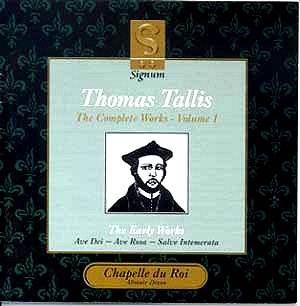This is the first of a projected full price series
to cover Tallis’s complete surviving output from his fifty years of
composition, and will include the sacred and secular music, and instrumental
material, much of which is as yet unrecorded; this should cover nine
discs. Great attention is to be paid to performance detail including
pitch, pronunciation and the music’s liturgical context, and as a result
new editions of the music are required, many of which will be published
by the Cantiones Press.
This recording includes church music written during
the first decade of his career, probably between 1530 and 1540. Relatively
little is known about Tallis’s life, particularly about his early years.
He was probably born in Kent during the first decade of the sixteenth
century, and is first noted as an organist at Dover Priory, a small
Benedictine monastery consisting of about a dozen monks. The next record
is in 1537-8 in London at the parish church of St-Mary-at-Hill in Billingsgate,
where a choir was maintained capable of singing music in five parts,
its repertory including Masses, antiphons, music for the Lady Mass and
‘carolles for cristmas’. In 1538, Tallis had moved to the Augustinian
abbey of Holy Cross at Waltham in Essex, a monetarily well endowed establishment,
very able to maintain a Lady Chapel choir. However, eighteen months
later, the abbey was dissolved during the course of the English Reformation.
He then became a noted lay-clerk at Canterbury Cathedral (the archbishop
at this time was Thomas Cranmer) where he stayed for two years before
being appointed a Gentleman (singer) of the Chapel Royal, where he stayed
for the rest of his life.
All the works on this disc are from Tallis’s early
compositions; Ave Dei patris, Ave rosa spina and Salve inemerata are
votive antiphons (settings of devotional texts sung after Compline,
the final service of the day, in front of the image or altar of the
saint to whom the text was addressed). Missa Salve intemerata is a small-scale
setting of the English Mass, whilst Ora pro nobis (An Alleluia) and
Euge celi porta are two items from the Lady Mass (the special votive
Mass of the Virgin) (a votive Mass is one offered with a particular
‘intention’ or one offered in honour of a saint on some day other than
the feast of that saint)
The Chapelle du Roi is a choir of ten young singers
specialising in the performance of sacred renaissance music and was
founded in October 1994. Its conductor, Alistair Dixon, is an early
music singer and conductor. He was educated at Millfield School as a
music scholar and graduated from Liverpool University. In 1994 he was
appointed a Gentleman in Ordinary at Her Majesty’s Chapel Royal, and
founded Chapelle du Roi in the same year. Throughout the disc, the singing
of all parts is uniformly good, with very clear diction, as befits a
small group, and great attention to detail. In the first two items,
there is, in parts, some slight shakiness of intonation, soon recovered,
but unfortunately it occurs in the more exposed passages where it stands
out more. The confidence is recovered quickly in the more richly scored
ensemble passages. Talking about the scoring, those used to Tallis’s
later and more well-known works will be surprised at the bareness and
earlier sounding harmonies, much more related to Tallis’s predecessors
such as Ludford and Fayrfax (both composers’ works are available on
the ASV Gaudeamus label). At times this can sound quite bare and monastic
in origin, particularly when preceded by a plainchant introduction;
as one approaches the later works this "hair-shirt" sound
is replaced by the more familiar false relations and enriched harmonies
so typical of Tallis’s music. By the way, at school many of us performing
music of this period nicknamed the false relation as "the English
cadence"; does anyone else have memories of this rather apt title?
Besides the expertise of the choir and conductor, the
booklet is extremely well researched and the history of both Tallis
and the works themselves are given the most expert and scholarly treatment
(I am grateful for their content in the opening paragraph of this review).One
quibble though; the booklet does not state who is singing in what piece,
nor the number or type of voice used in each item - a surprising omission
in such an otherwise admirable issue. Translations from the Latin text
are given in English, French and German for all pieces. Throughout the
recording is excellent, with good presence and a satisfying surround.
Further discs are awaited with eager anticipation, and to anyone interested
in this period of English music, or those wanting to acquire knowledge
of the same, this disc is a must. Wholeheartedly recommended.
John Portwood


